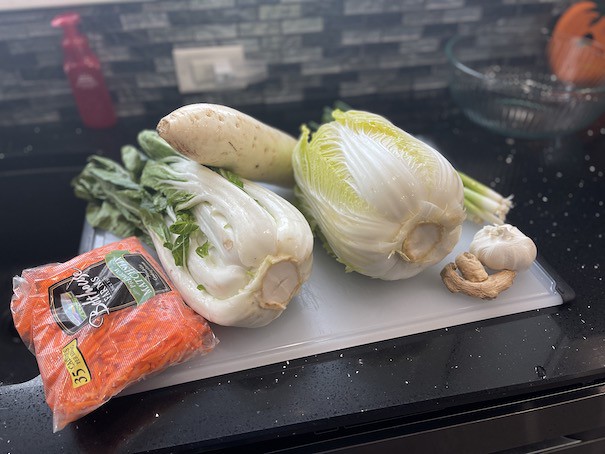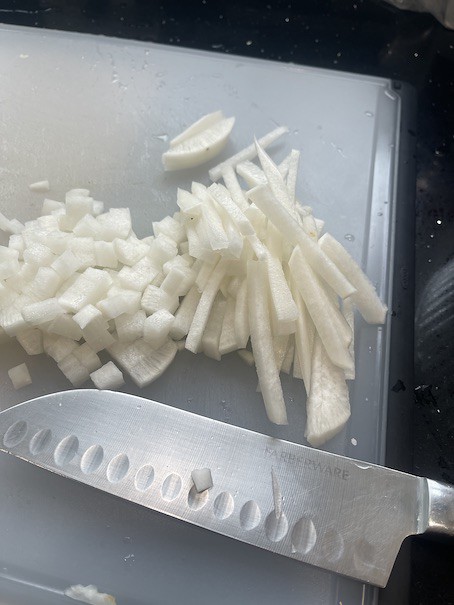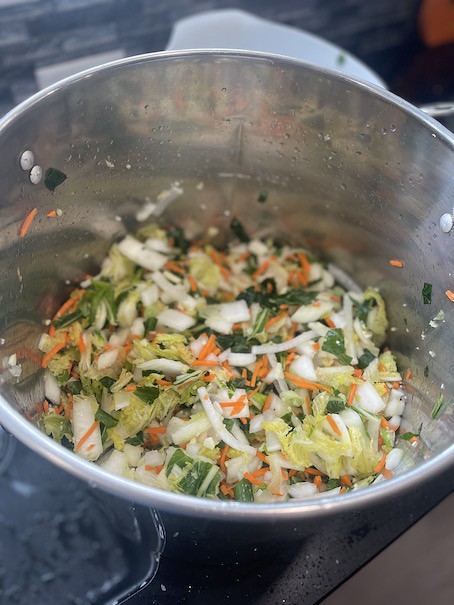First off … what’s Kimchi.
Kimchi is a fermented food that is from Korea, similar to sauerkraut since it uses cabbage and is fermented … but that’s the only similarity. It’s a staple side dish the Korean cuisine.
Kimchi is typically made from fermented cabbage, radish, cucumber, green onion and brussel spouts even. There are various types and named differently for the vegetable used.
Click here to see the info: First the ingredients: Now for the ingredients that you’ll have to look for Now additional adds .. I’ve read about Asian pears, plums, oysters, squid to name a few Starting with your throughly rinsing cabbage. Cut the napa cabbage lengthwise into quarters and discard roots. For the bok choy cut end of root off and discard any outer bad leaves. Cut napa cabbage and bok choy into approx. 2” square pieces. Keep bite size but not too small. Put napa cabbage and bok choy into a large bowl or crock. Sprinkle the 1/2 cup salt all over and turn over and sprinkle. Make sure the salt is blended into cabbage. Let sit and turn over every 30 minutes for 1-1/2 hours. Alternate option is to cover with cold water, approx. 12 cups. Cover with a plate to keep cabbage mixture submerged and cover with a towel or plastic wrap and let sit on counter at room temperature for 12 to 24 hours. Next peel and cut daikon radish in match sticks size and/or small cubes. And then add to the salted cabbage. You can also skip this addition … but I typically get the cabbage going first and then add the daikon. But have also completely skip brining the radish. Cut and combine all the other ingredients into large glass or metal bowl while the cabbage is brining / resting with the salt. Next after 1 to 1-1/2 hours of total salting throughly rinse the cabbage in cold water 3 times to clean it. You should NOT taste any salt left in the cabbage mixture And then drain completely in a colander IMPORTANT NOTE: Do NOT use WHITE plastic bowls past this point. Use glass, metal or something that will not get stained! Combine all the other ingredients – I’m using a stainless steel pot. Starting mixing in the red pepper flakes, chili paste, fish sauce and any other additions. Trying not to bruise or break cabbage upon mixing and combining the ingredients. I wear nitrile gloves and mix by hand. Again if you don’t wear gloves … your hands will turn red and possibly burn / irritate your skin. Taste me … use a spoon or wear gloves! You can add water, more Gochujang, or even soy sauce, if you need more juice / liquid. But trust me … it will seem “dry” at first until you start packing the mixture Start to pack tightly into glass containers or air-tight sealable plastic container (I prefer using a 1 gallon glass jar) – You can use canning jars even. But if you are using plastic … you will never get the smell or stains out of it. Pack the mixture into the container and do not allow voids or air pockets. Leaving about 1/2″ to 3/4″ head-space at the top of jar(s). Cover loosely with a lid, cover with cheese cloth or use an airlock. I’m using an airlock this go around. Also placing the vessel onto a plate in case the ferment bubbles out the top – Thus why you need to leave some head-space. Let sit in mild, dark place for 24 hours (or room temperature for 12 hours covered) After resting open the lid to release gases (if not using an airlock) that have built up and repress mixture tightly into container. The mixture should be covered by the natural brine it has made. Then refrigerate your kimchi and eat as soon as your liking. Kimchi is an acquired taste for some … but give a chance and you never know, you may love it!
Now I have to confess
I just eyeball and wing it when making Kimchi – (But below is my starter recipe)
Once you’ve made it a few times … you just add or subtract as neeeded.
(At least 2-1/2 lbs mininum cabbage or combination)
(Add more for spicy hotter Kimchi – I use Assi Brand Red Pepper Powder)
(Available in most Korean / Asian markets or Amazon)
(You can skip complete, or even make a rice flour porridge but Gochujang is easiest)
(The last couple batches I started use this – I use Chung Jung One O’Food)
(Available in most Korean / Asian markets or Amazon)
But sure to check kimchi periodically for built up gases and liquid release.













